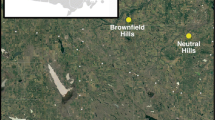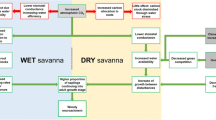Abstract
With biomass densities comparable to large ungulates and megaherbivores, termites play a key functional role in many tropical savanna ecosystems. This study focuses on vegetated termite mounds (termitaria) constructed by the Termitidae species Macrotermes herus. We studied how resource rich termitaria affect graminoid herbs (Poaceae and Cyperaceae), forbs and woody species composition and diversity. The density of termitaria explained 89% of the variation in dense thickets in the area. Fire tolerant Acacia species dominated the open savanna while fire sensitive species like Grewia spp. and the succulent Euphorbia candelabrum were restricted to termite mounds. Termitaria plots had four times the mean number of woody species and supported three times as many forb species as the adjacent savanna. For woody species, both the Shannon–Wiener index and the Shannon evenness index were higher on temitaria than on the savanna. There were no differences for graminoid herbs, except for the Shannon evenness index which was higher on termitaria. Our results indicate that graminoid herb richness peaks at lower productivity levels than trees and forbs in savanna ecosystems, as also recently found in temperate areas.


Similar content being viewed by others
References
Abe T (1980) Studies on the distribution and ecological role of termites in a lowland rain forest of West Malaysia. 4. The role of termites in the process of wood decomposition in the Pasho Forest Reserve. Rev d’Ecol et de Biol du Sol 17:23–40
Anderson JM, Wood TG (1984) Mound composition and soil modification by two soil-feeding termites (Termitinae, Termitidae) in a riparian Nigerian forest. Pedobiologia 26:77–82
Arshad MA (1982) Influence of the termite Macrotermes michaelseni (Sjöst) on soil fertility and vegetation in a semi-arid savannah ecosystem. Agro-Ecosyst 8:47–58
Asawalam DO, Osodeke VE, Kamalu OJ, Ugwa IK (1999) Effects of termites on the physical and chemical properties of the acid sandy soils of Southern Nigeria. Commun Soil Sci Plant Anal 30:1691–1696
Bakuneeta CM (1989) The importance of Macrotermes herus (Sjostedt) to the ecosystems in Queen Elizabeth and Lake Mburo National Parks in Uganda. MSc Thesis, Makerere University, Uganda
Bell RHV (1982) The effect of soil nutrient availability on community structure in African ecosystems. In: Huntley BJ, Walker BH (eds) Ecology of tropical savannas. Springer, Berlin, pp 193–216
Bloesch U (2002) The dynamics of thicket clumps in the Kagera savanna landscape, East Africa. PhD thesis, Swiss Federal Institute of Technology, Zurich, Switzerland
Bloesch U (2008) Thicket clumps: a characteristic feature of the Kagera savanna landscape, East Africa. J Veg Sci 19:31–44
Bryant JP, Stuart Chapin F, Klein DR (1983) Carbon/nutrient balance of boreal plants in relation to vertebrate herbivory. Oikos 40:357–368
Button TW, Arshad MA, Tieszen LL (1983) Stable isotope analysis of termite food habits in East African grasslands. Oecologia 59:1–6
Cornwell WK, Grubb PJ (2003) Regional and local patterns in plant species richness with respect to resource availability. Oikos 100:417–428
Crawley MJ, Johnston AE, Silvertown J, Dodd M, de Mazancourt C, Heard MS, Henman DF, Edwards GR (2005) Determinants of species richness in the park grass experiment. Am Nat 165:179–192
Dangerfield JM, McCarthy TS, Ellery WN (1998) The mound-building termite Macrotermes michaelseni as an ecosystem engineer. J Trop Ecol 14:507–520
Donovan SE, Eggleton P, Dubbin WE, Batchelder M, Dibog L (2001) The effect of a soil-feeding termite, Cubitermes fungifaber (Isoptera: Termitidae) on soil properties: termites may be an important source of soil microhabitat heterogeneity in tropical forests. Pedobiologia 45:1–11
Eggleton P, Bignell DE, Sands WA, Mawdsley NA, Lawton JH, Wood TG, Bignell NC (1996) The diversity, abundance and biomass of termites under differing levels of disturbance in the Mbalmayo Forest Reserve, southern Cameroon. Phil Trans Royal Soc Lond 351:51–68
Eldridge DJ (1994) Nests of ants and termites influence infiltration in a semi-arid woodland. Pedobiologia 38:481–492
Ferrar P (1982) Termites of a South African savanna IV. Subterranean populations, mass determinations and biomass estimations. Oecologia 52:147–151
Frost PGH (1996) The ecology of miombo woodlands. In: Campbell BM (ed) The miombo transition: woodland and welfare in Africa. Centre for International Forestry Research, Bogor, Indonesia, pp 11–57
Gillon D (1983) The fire problem in tropical savannas. In: Bourlière F (ed) Tropical savannas. Ecosystems of the world 13. Elsevier, New York, pp 617–641
Gross KL, Mittelbach GG, Reynolds HL (2005) Grassland invasiblity and diversity: responses to nutrients, seed input, and disturbance. Ecology 86:476–486
Gurevitch J, Scheiner SM, Fox GA (2002) The ecology of plants. Sinauer Associates Inc., Sunderland, Massachusetts, USA
Haines RW, Lye KA (1983) The sedges and rushes of East Africa. The East Africa Natural History Society, Nairobi, Kenya
Hesse PR (1955) A chemical and physical study of the soils of termite mounds in East Africa. J Ecol 43:449–461
Higgins SI, Shackleton CM, Robinson ER (1999) Changes in woody community structure and composition under contrasting landuse systems in a semi-arid savanna, South Africa. J Biogeogr 26:619–627
Hoag A, Clements A, Monday G (1991) Lake Mburo National Park Habitat Project. A study of the vegetation composition and animal use of the major terrestrial habitats in the park. USAID, USA
Jaccard P (1928) Die statistisch-floristische Methode als Grundlage der Pflanzensoziologie. In: Abderhalden (ed) Handbuch biologischer Arbeitsmethoden, vol 11, pp 165–202
Jones JA (1992) Soil formation and nutrient dynamics at the woodland-savanna boundary in East Africa. In: Furley PA, Proctor J, Ratter JA (eds) Nature and dynamics of forest-savanna boundaries. Chapman & Hall, London, UK, pp 185–212
Jones MJ, Wild A (1975) Soils of the west African savanna. Commonwealth Africultural Bureax (CAB) Technical Communication, vol 55. Commonwealth Agricultural Bureau, Harpenden, pp 1–246
Jones CG, Lawton JH, Shachak M (1994) Organisms as ecosystem engineers. Oikos 69:373–386
Katende AB, Birnie A, Tengnä B (1995) Useful trees and shrubs for Uganda. Regional Soil Conservation Unit (RSCU/SIDA), Nairobi, Kenya
Knight RS, Rebelo AG, Siegfried WR (1989) Plant assemblages on Mima-like earth mounds in the Clanwille district, South Africa. S Afr J Bot 55:465–472
Konatè S, Le Roux X, Tessier D, Lepage M (1999) Influence of large termitaria on soil characteristics, soil water regime, and tree leaf shedding pattern in a West African savanna. Plant Soil 206:47–60
Lal R (1988) Effects of macrofauna on soil properties in tropical ecosystems. Agric Ecosyst Environ 24:101–116
Langdale-Brown I, Osmaston HA, Wilson JG (1964) The vegetation of Uganda and its bearing on the land use. Government Printer, Entebbe, Uganda
Lavelle P, Bignell D, Lepage M, Wolters V, Roger P, Inneson P, Heal OW, Dhillion S (1997) Soil function in a changing world: the role of invertebrate ecosystem engineers. Eur J Soil Biol 33:159–193
Lawton JH, Bignell DE, Bloemers GF, Eggleton P, Hodda ME (1996) Carbon flux and diversity of nematodes and termites in Cameroon forest soils. Biodiv Cons 5:261–273
Lee KE, Wood TG (1971) Termites and soils. Academic press, London
Lèonard J, Rajot JL (2001) Influence of termites on runoff and infiltration: quantification and analysis. Geoderma 104:17–40
Lind EM, Morrison MES (1974) East African vegetation. Longman, London, UK
Lobry de Bruyn LA, Conacher AJ (1990) The role of termites and ants in soil modification: a review. Austr J Soil Res 28:55–93
Loveridge JP, Moe SR (2004) Termitaria as browsing hotspots for African megaherbivores. J Trop Ecol 20:337–342
Maduakor HO, Okerere AN, Onyeanuforo CC (1995) Termite mounds in relation to surrounding soils in the forest and the derived savanna zones of southeastern Nigeria. Biol Fert Soils 20:157–162
Mahaney WC, Zippin J, Millner MW, Sanmugadas K, Hancock RGV, Aufreiter S, Cambell S, Huffman MA, Wink M, Malloch D, Kalm V (1999) Chemistry, mineralogy and microbiology of termite mound soil eaten by chimpanzees of the Mahale Mountains, Western Tanzania. J Trop Ecol 15:565–588
Mando A, Brussaard L (1999) Contribution of termites to the breakdown of straw under Sahelian conditions. Biol Fert Soils 29:332–334
Mando A, Brussaard L, Stroosnijder L (1999) Termite- and mulch-mediated rehabilitation of vegetation on crusted soil in West Africa. Restor Ecol 7:33–41
Martius C (1994) Diversity and ecology of termites in Amazonian forests. Pedobiol 38:407–428
McCarthy TS, Ellery WN, Dangerfield JM (1998) The role of biota in the initiation and growth of islands on the floodplain of the Okavango alluvial fan, Botswana. E Surf Proc Landf 23:291–316
Miedema R, Van Vuure W (1977) The morphological, physical and chemical properties of two mounds of Macrotermes bellicosus (Smeathman) compared with surrounding soils in Sierra Leone. J Soil Sci 28:112–124
Mobæk R, Narmo AK, Moe SR (2005) Termitaria are focal feeding sites for large ungulates in Lake Mburo National Park, Uganda. J Zool Lond 267:97–102
Nutting WL, Haverty MI, LaFage JP (1987) Physical and chemical alteration of soil by two subterranean termite species in Sonoran Desert grassland. J Arid Env 12:233–239
Nyamphene KW (1986) The use of termite mounds in Zimbabwe peasant agriculture. Trop Agric 63:191–192
Okwakol MJN (2000) Changes in termite (Isoptera) communities due to the clearance and cultivation of tropical forest in Uganda. Afr J Ecol 38:1–7
Owen-Smith RN (1988) Megaherbivores: the influence of very large body size on ecology. Cambridge University Press, Cambridge, UK
Palgrave MC (2002) Trees of Southern Africa, 3rd edn. Struik Publ, Cape Town, South Africa
Pérez-García EA, Meave JA (2006) Coexistence and divergence of savanna and tropical dry forest in southern Mexico. J Biogeog 33:438–447
Phillips S, Namaganda M, Lye KA (2003) 115 Ugandan grasses. Makerere herbarium handbook no. 1. Makerere University, Uganda
Pomeroy DE (1983) Some effects of the mound-building termites on the soils of a semi-arid area of Kenya. J Soil Sci 34:555–570
Rannestad OT, Danielsen T, Moe SR, Stokke S (2006) Adjacent pastoral areas support higher densities of wild ungulates than the Lake Mburo National Park in Uganda. J Trop Ecol 22:675–683
Sabiiti EN, Wein RW (1987) Fire and Acacia seeds: a hypothesis of colonization success. J Ecol 74:937–946
Sharam G, Sinclair ARE, Turkington R (2006) Establishment of broad-leaved thickets in Serengeti, Tanzania: the influence of fire, browsers, grass competition, and elephants. Biotropica 38:599–605
Tilman D (1988) Plant strategies and the dynamics and structure of plant communities. Monographs in population biology. Princeton University Press, Princeton, New Jersey, USA
Tropin G (1983) Flore du Rwanda. Spermatophytes, vol 1–3. Musee Royal de L’Afrique Centrale, Tervuren, Belgique
Watson JP (1969) Water movement in two termite mounds in Rhodesia. J Ecol 57:441–451
Watson JP (1976) The composition of mounds of the termite Macrotermes falciger (Gerstäcker) on soil derived from granite in three rainfall zones of Rhodesia. J Soil Sci 27:495–503
Watson JP (1977) The use of mounds of the termite Macrotermes falciger (Gerstäcker) as a soil amendment. J Soil Sci 28:664–672
Whittaker RH (1977) Evolution of species diversity in land communities. In: Hecht MK, Steere WS, Wallace B (eds) Evolutionary biology, vol 10. Plenum Press, New York, USA, pp 1–67
Wild H (1952) The vegetation of southern Rhodesian termitaria. Rhod Agric J 49:280–292
Wood TG (1978) Food and feeding habits of termites. In: Brian MV (ed) Production ecology of ants and termites. Cambridge University Press, Cambridge, UK, pp 55–90
Wood TG, Sands WA (1978) The role of termites in ecosystems. In: Brian MV (ed) Production ecology of ants and termites. Cambridge University Press, Cambridge, UK, pp 245–292
Acknowledgements
We thank the Uganda Wildlife Authority and the Uganda National Council for Science and Technology for permission to conduct this study. J. Colman and O. G. Støen commented on earlier drafts of this manuscript. Dr. C. Bakuneeta and D. K. Aleper assisted during the study. O. Wanyana Magyani and Prof. K. A. Lye helped in identifying plant species. We are grateful to the park staff for their hospitality and support. In particular, we would like to thank K. T. Anderson for assistance in the field. This study was supported by grants from Noragric at the Norwegian University of Life Sciences and by NUFU.
Author information
Authors and Affiliations
Corresponding author
Rights and permissions
About this article
Cite this article
Moe, S.R., Mobæk, R. & Narmo, A.K. Mound building termites contribute to savanna vegetation heterogeneity. Plant Ecol 202, 31–40 (2009). https://doi.org/10.1007/s11258-009-9575-6
Received:
Accepted:
Published:
Issue Date:
DOI: https://doi.org/10.1007/s11258-009-9575-6




